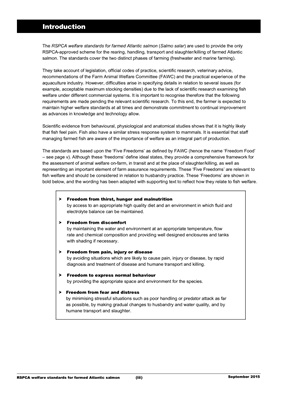
RSPCA welfare standards for farmed Atlantic salmon (iii) September 2015
Introduction
The RSPCA welfare standards for farmed Atlantic salmon (Salmo salar) are used to provide the only
RSPCA-approved scheme for the rearing, handling, transport and slaughter/killing of farmed Atlantic
salmon. The standards cover the two distinct phases of farming (freshwater and marine farming).
They take account of legislation, official codes of practice, scientific research, veterinary advice,
recommendations of the Farm Animal Welfare Committee (FAWC) and the practical experience of the
aquaculture industry. However, difficulties arise in specifying details in relation to several issues (for
example, acceptable maximum stocking densities) due to the lack of scientific research examining fish
welfare under different commercial systems. It is important to recognise therefore that the following
requirements are made pending the relevant scientific research. To this end, the farmer is expected to
maintain higher welfare standards at all times and demonstrate commitment to continual improvement
as advances in knowledge and technology allow.
Scientific evidence from behavioural, physiological and anatomical studies shows that it is highly likely
that fish feel pain. Fish also have a similar stress response system to mammals. It is essential that staff
managing farmed fish are aware of the importance of welfare as an integral part of production.
The standards are based upon the 'Five Freedoms' as defined by FAWC (hence the name 'Freedom Food'
- see page v). Although these 'freedoms' define ideal states, they provide a comprehensive framework for
the assessment of animal welfare on-farm, in transit and at the place of slaughter/killing, as well as
representing an important element of farm assurance requirements. These 'Five Freedoms' are relevant to
fish welfare and should be considered in relation to husbandry practice. These 'Freedoms' are shown in
bold below, and the wording has been adapted with supporting text to reflect how they relate to fish welfare.
Freedom from thirst, hunger and malnutrition
by access to an appropriate high quality diet and an environment in which fluid and
electrolyte balance can be maintained.
Freedom from discomfort
by maintaining the water and environment at an appropriate temperature, flow
rate and chemical composition and providing well designed enclosures and tanks
with shading if necessary.
Freedom from pain, injury or disease
by avoiding situations which are likely to cause pain, injury or disease, by rapid
diagnosis and treatment of disease and humane transport and killing.
Freedom to express normal behaviour
by providing the appropriate space and environment for the species.
Freedom from fear and distress
by minimising stressful situations such as poor handling or predator attack as far
as possible, by making gradual changes to husbandry and water quality, and by
humane transport and slaughter.